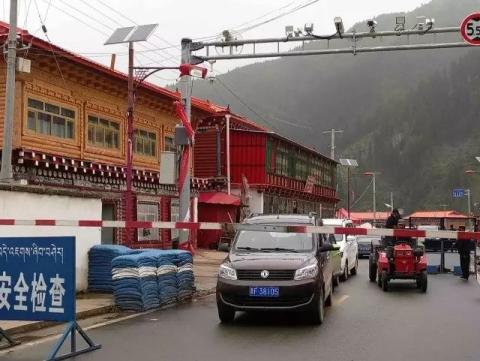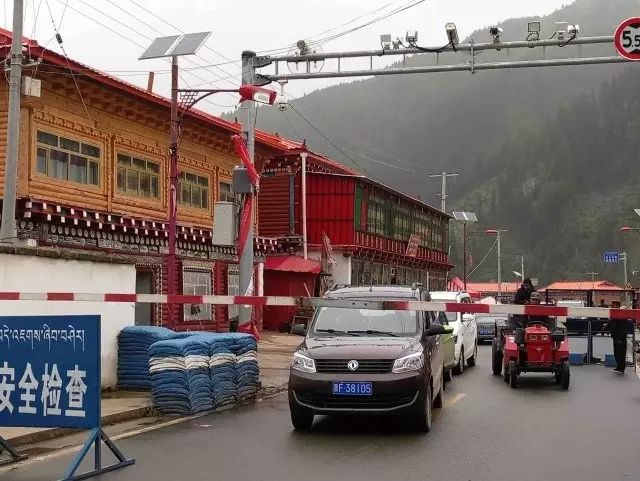
Western Sichuan Grand Ring Tour
DAY 3
The Buddhist School is about to disappear
○ Sneaker novice
07
Monday
August 2017
Weather: It rains non-stop
Altitude: always above 4009 meters
Banma – Seda
Moved to Seda
God was unfavorable and the trip on the third day in western Sichuan had to be diverted to Seda. So, the team entered Ganzi Prefecture from Aba Prefecture. (Photos are not allowed at the checkpoint, so I secretly took one.)

The purpose of this trip is to see the famous Wuming Buddhist College, whose full name is Larung Gar Wuming Buddhist College in Seda County. It is located in Larung Valley about 20 kilometers southeast of Seda County, Garze Tibetan Autonomous Prefecture, Sichuan Province.

Surrounded by mountains and densely covered with red monk houses on the hillside, this is Wuming Buddhist College, which has risen rapidly since its establishment in 1980 and has an extraordinary status. From the 32 people when it was first built, it is said that more than 40,000 monks now live and practice here. (Pull to a close-up view to see what the house looks like.)


Complaints about Yiyuan
The team soon arrived at the bus connection station up the mountain from Wuming Buddhist College. There is a bus here for round-trip transportation. The fare is three yuan, and there is no change for self-service coins. (There are reconstruction works everywhere, and it’s raining, so it’s worth waiting in line for the bus.) It should be noted that one-yuan coins cannot be used when entering the plateau. You need to use banknotes. The reason is that coins are not available in the local area. Easy to store. (Imagine that you dropped a coin. It definitely didn’t fall where it was. It just rolled away along the mountain and could never be found again...)
It should also be mentioned that the public toilets here are charged, one yuan per use. (Only the public toilets in Seda are free in the entire western Sichuan trip.) Some are built in small courtyards. If you see someone coming to use the toilet, a child will run out and tell you very politely: " Want to go to the toilet? One yuan once!” (After spending one yuan twice along the way, the sneaker guy exchanged N one-yuan notes, and he didn’t even use them up until Chengdu...)


Insights from Wuming Buddhist College
Red monks’ houses, red monks’ robes, red exterior walls of ashram buildings… everywhere you look, red is everywhere.
As the bus moved forward, a group of red cabins stretching for several kilometers gradually emerged. These are the dormitories of lamas (male monks) and juemu (female monks) who practice and study here. Lamas and Juemu in red robes come and go here, and they also squeeze in the only bus with tourists.
After getting off the bus, there is a winding plank road on the left that is obviously newly built. You can go up to the top of the mountain and have a panoramic view of the Buddhist Academy.

Before we went, the buildings of Wuming Buddhist College were already being re-planned. Several fire escapes were opened among the densely packed houses; while regular-looking houses were rebuilt on other hills to accommodate the transfer and residence of Buddhist college students. Therefore, now we see several deep ditches among the buildings of the Buddhist academy, just like Duan Yu's comment on Mrs. Wang's flowers in "The Legend of the Dragon": The beauty scratches her face.
Today, there are still more than 40,000 monks living in the Buddhist Academy, and tourists have gradually begun to move to Yaqing Temple. (Yaqing Temple is located 122 kilometers outside Baiyu County, Garze Tibetan Autonomous Prefecture. It is a large-scale study place as famous as Seda Buddhist College.)



It rained heavily that day, and the sneaker guy did a very unwise thing. He unloaded his luggage at the accommodation before eating. He didn't bring an umbrella or a raincoat, so he went directly to Seda with his wallet and mobile phone. Buddhist College, luckily I was wearing a jacket. Such heavy rain made us feel tired during the visit.
Walk along the concrete road at the bottom of the valley among the ant nest-like red houses. If you look carefully, you can see that the wooden house has some repair marks occasionally and the color is very bright. There are almost no gaps between houses, and leftover building materials can be seen piled in the corners everywhere. Taking pictures of details will definitely ruin the image of the Buddhist college.
When we got to the Daochang Lecture Center, we only saw a vegetable and fruit shop and a public toilet along the street. Apart from the passage that was being excavated, the only original path up the mountain in this section was the one next to the Daochang Lecture Center ( Currently being revised and expanded) , novices like sneakers who like to find safe exits when visiting strange places will definitely not consider staying here. (I’m really scared. It’s hard to walk with so many people and so few roads~)



Although the jacket has a certain water-repellent function, it couldn't withstand the heavy rain, and I felt a little cold when I walked to the main venue. (You must wear more clothes on the plateau!)
You need to take off your shoes to enter the porch of Daochang, and there are storage areas on both sides. I secretly opened the door curtain and peeked inside. There were monks giving lectures inside. Before I could take a closer look at us lay people, we were dragged out by a Juemu at the door. Okay, just lie down on the porch.
Speaking of which, the porch is very beautiful ~ various thangkas, colorful ceilings, and murals with Buddhist stories.


The Buddhist academy has strict precepts, and the monks practice alone among the constant flow of tourists. Tourists are not allowed to visit the Daochang Lecture Office, but there will be a green carpet under the corridor at the entrance. As long as tourists store their shoes, they can rest here.
This is the place with the most tourists, and there are also monks who cover their heads and faces with cassocks and sit in meditation among the crowd.

After a short rest, the jacket and quick-drying pants were completely dry, so I entered the rain again to look for the true face of the Buddhist College. The boy in sneakers walked up the passage next to the lecture hall. Looking back, the golden dome of the dojo in front of me and the red houses in the mountains and valleys in the distance are once again shocking.

The dojo is divided into front and back halls, with an aisle in the middle. It also has the characteristic that if there is open space, there must be debris piled up.
(Only half of it was taken, but it’s still very beautiful.)

A "sunroom" was built behind the apse, where monks studied quietly.
(It feels like the atmosphere of our library here.)

The monks’ dormitories are densely packed around them, and the small red rooms are arranged as neatly as possible. There are flowers in front of the window of this room, it should be Juem's dormitory.
Halfway through, I started experiencing symptoms of chest tightness and asthma. After all, the altitude is 4,000+, and some dormitories are really far away from the dojo. It feels like going back and forth every day is a kind of practice.


Tour the mandala alone
This time it was him again - Zhao Wumian, who was equipped with "internal strength", climbed the highest mountain of the Buddhist Academy alone. Only he knew whether there was an opportunity for divine revelation here!
Mandala, which means "mandala" in Sanskrit, is a place for praying. (Tantric practitioners use it as the object of meditation, and then visualize their own body as a mandala. The deity rests on the lotus seat in the heart, that is, contemplating the body as the deity, and does not leave it for a moment. Over time, the practice will become more profound, and the body, speech, and mind will be in harmony with the deity. No two, reaching the highest state of becoming a Buddha.) Many believers come here to circle the mandala. It is said that all diseases will disappear after 100 turns.

When I was about to leave, I saw that the main structure of the new Buddhist college building had been completed, like building blocks stacked with square heads and square heads.
The beautiful characteristic buildings of Wuming Buddhist College may soon disappear, and the stacked red huts built against the mountains may be replaced by these integrated blocks.

Missed “Sky Burial”
It was already in the afternoon when we set off from Banma County to Seda, and we missed the sky burial ceremony at the Shiduolin Sky Burial Platform, which is held at one o'clock and three o'clock every day. It is understood that before the sky burial begins, the lama will chant sutras to save the soul and go to heaven. Afterwards, the deceased will be sent to the sky burial platform, where the sky burial master will cut the body into pieces with a knife and attract vultures to peck at them.
Tibetans believe that people come from nature and eventually return to nature. Life is a cycle.
(The picture below is from the Internet)

HypoxiaSeda
Seda is a place with low vegetation coverage but highly dense population. Hypersensitivity has become very serious here. Along the way, the sneaker novice had no obvious symptoms of hyperreflection, but on the night in Seda, he woke up with a headache at two o'clock in the morning. By massaging the meridians of the head and tapping the Fengchi point, the migraine was barely relieved, and I fell asleep again in a haze.
High reflex is not only troubled by low air pressure, but low oxygen content is also a big killer.

expensive accommodation
Accommodation in Seda was the most expensive place along the trip, more than twice as expensive as accommodation in other places, and it was difficult to book a room. Because there are too many uncertainties during the trip to Western Sichuan, hotel reservations can only be made one or two days in advance.
To make matters worse, such an expensive hotel had a power outage on the day we checked in! ! ! The boss said he would call after ten o'clock, but the call didn't come until we fell asleep. (The boss gave a candle...)

Early morning turret
The sneaker guy finally overcame the headache caused by high blood pressure. When he woke up, he saw the White Tower outside the hotel! ! !



I have seen an endless stream of people turning the tower here since yesterday, so Renzai Lvtu and his teammates couldn’t help but participate. Following the footsteps of the Tibetans and coming to the front of the White Pagoda, I realized that this White Pagoda has a lot of history and is the reincarnation of the 10th Panchen Lama.
There is a stone ridge on one side of the front of the pagoda. Starting from this point, men on the left and women on the right began to turn the pagoda clockwise, ending our journey in Seda with prayers.

Special thanks to: teammate Sunshine Rain,
Dark fragrance Wuhen, Zhao Wumian authorized to provide some pictures
